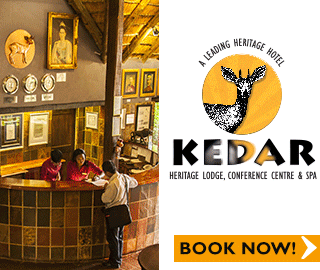
Kalahari: The Place Of Healing
BY JO KROMBERG 5TH NOV, 2014 13:24
“There are only a few places in the world where the mere mention of a name is enough to unlock a wealth of memories and an unknown yearning in anyone whoknows and appreciates it. The Kalahari is such a place.” - J. du P. Bothma, 1998
My heart has been replaced by a hysterical, maniacal thumping ball beneath my solar plexus, looking for the closest exit. “Is it going to be like this for the entire flight?” The pilot doesn’t hear me above the noise so I’m forced to repeat these, what could very well be my last words. He flashes a brilliant smile at me as though he’s about to announce that I am this week’s lucky lotto winner. “No! We’re climbing to get out of the wind. As soon as we’re above 7 000 feet it’ll be fine!” He exchanges a side-long glance with his co-pilot and they share a mischievous smile at my intense consternation of being thrown around the Kalahari sky like an unhinged cartoon character. Luckily, the flight on lasts only for 30 minutes and after everything is said and done, the pilots do very well, considering the strength of the wind. We land safely and I extend a shaky hand to Tiaan, my co-host at Grasslands Safari Lodge, who swiftly drives me to the lodge and to a cold beer. The lodge is family owned and run and the emphasis is on relaxation, comfort, home cooking and hospitality. I find my bearings and take a good look at my surroundings.
According to http://www.eyesonafrica.net/african-safari-botswana/kalahari-safari.htm, few place names are as evocative as the Kalahari. This misspelt Anglicism has come to represent the vastness of Africa's outback with all the romantic undertones of nomadic hunter-gatherers, lions and golden grasslands gently waving under the canopy of a limitless blue sky. The Kalahari Desert is in Southern Africa and extends some 900 000 square kilometres; covering 84% of Botwana and sections of Namibia and South Africa. The surrounding Kalahari Basin of 2 500 000 square kilometres, extends farther in to Botwana, Namibia and South Africa and infringes on parts of Angola, Zambia and Zimbabwe. 'Desert', however, is a misnomer: its earliest travellers defined it as a 'thirstland'. Most of the Kalahari (or Kgalagadi, which is its Setswana name) is covered with vegetation, including stunted thorn and scrub bush, trees and grasslands. In winter (June, July and August) the Kalahari takes on varying hues of white gold. Because August and September are also the windy months, the dust turns the sun into a molten mass of reds, oranges and pink as it sets and rises over the endless dunes and forlorn wavy grasslands. With little more than 100 to 200mm of rainfall per year, the fauna and flora in the Kalahari wages a daily struggle for survival.
Grasslands, my home from home, is my first stop in this breathtakingly dry paradise. I’m shown to my rustic thatched and stone chalet with its aroma of nature and the cool interior hits me like welcome splash of cold water. The chalet has been decorated with deference to its surrounds and is beautifully balanced in terms of luxury and natural materials used. I decline the game drive offer in favour of spending the afternoon enveloped in the warm sunshine beating down on the primordial veldt. Later, upon her return from a Bushmen walk with guests, I meet the very charming and knowledgeable Neeltjie, Tiaan’s wife and co-manager of Grasslands.
Neeltjie grew up in the area and speaks fluent San, the unique and (to a Westerner’s ear) intriguingly impenetrable click language of the Bushman.During sundowner drinks around the fire, we share bush stories, watching kudu, eland, duiker and even a jackal having a drink at the watering hole within a few metres from where we are sitting. Suddenly the Canadian sitting opposite me jumps sky high. “What was that?” The high-pitched, trembling voice is incongruent with his sturdy stature outfitted in all ‘Out of Africa’ gear, completed with a Safari hat. We look at him incredulously. “That’s a lion roaring,” explains Neeltjie. “But is it close? It sounds so close,” the nervous man giggles. “Don’t worry, sound travels very far here,” says Neeltjie, winking at me. I sleep soundly that night, the beautiful lyrics of Gene Pitney haunting me as I drift off: “Something’s gotten hold of my hand, dragging my soul to a beautiful land. Something has invaded my nights, painting my sleep with a colour so bright ..."The following day Neeltjie explains to me that Grasslands still borders some of the big cattle farms in Botswana and that there has been some unhappiness between the farmers and game lodge management regarding the lions’ preference for beef . A solution to this is the subject of an entire feature article in a future issue of Nomad Africa Magazine.
The pioneering project is backed by some of the biggest sustainable resource developers and custodians in the world so watch this space...After a delicious lunch, it’s time for a long siesta, after which we go for a walk with the Bushmen. We meet what seems to me the entire cast of the classic movie, The Gods must be Crazy and they take us foraging for food. “To us it looks like dry bush everywhere,” explains Neeltjie. “To them it’s a huge supermarket.” And so it is – we become increasingly astonished as they show us how to make rope from leaves; as well as plants, shrubs, roots and bark that can respectively be used to eat as snacks and vegetables, used as perfume and cure anything from menstrual cramps to recurring migraines.
Neeltjie tells us that there are only about 18 000 of these golden-skinned, compactly built and guileless San people still left in the world. They are the only original inhabitants of the entire southern African region. But because they cannot understand the concepts of violence, aggression, deceit and subterfuge, they have been virtually decimated – first by the Khoi, then by central and West African migratory tribes and finally by the white colonists. Today, the only area left to them is the arid Kalahari. The San is a matriarchal cultural, with the women choosing the men they want and then setting them to work. (do not want to appear sexist, hence the lines deleted!)That night around the fire under a black sky, new moon and countless shining stars, we ruminate philosophically about definitions of civilisation and poverty. The San people certainly induce humbleness and a sense of stupid and superfluous clumsiness in all but the most jaded and arrogant cynic. They inadvertently put things in perspective, as does this whole wide land.After reluctant farewells the following day it’s off to my final Kalahari destination – the ominously named Deception Valley in the central Kalahari.
Apparently the name is derived from the mirages observed over the pans – shimmering blue and white layers that resemble a body of water from a distance. The technical definition is an optical illusion in which atmospheric refraction by a layer of hot air distorts or inverts reflections of distant objects. My hosts at the beautiful Deception Valley Lodge are Nadia, Jason, Wanda and Adriaan and between them, the other rangers and owners, they have about 65 years of experience in the hospitality and conservation industries. They certainly know what they’re doing, making guests feel completely at home and comfortable. Strangely enough, the ultra-luxurious five star lodge does not feel out of place in the bush. The owners built the lodge with their own hands over a prolonged period of time, making sure the environment wasn’t damaged in the process.
One of the owners and his wife travelled all over Africa for years, collecting artefacts and the design and décor of the lodge reflects this superbly. It is a deeply authentic and knowledgeable confluence of all things African. The chalets are virtually palatial - double storey suites with lovingly selected furnishings and the finest linen; not to speak of the genuinely Victorian baths. I join Nadia on the veranda of the main building and she tells me there is only one rule – no walking after dark. The animals – including lion, leopard and cheetah – all roam free and this is actually their domain; we are only visitors. I quietly think that I don’t want to go from visitor to snack and am quite happy to adhere to this very sensible rule.
The lodge offers game drives twice a day, night and day walks, as well as walks with the Bushmen. And the food – ah the food! I meet Onkiymetsi, the local epicurean magician, self-taught with additional training by the staff. As far as I’m concerned, a number of Michelin stars here won’t be out of place. The Oryx steak accompanied by in-season vegetables and the most divine mash potatoes I have ever sampled was inspirational. The following morning after a delicious English breakfast with all the trimmings, we are taken to the very, very exclusive manor house on the property. Recently completed, this location offers complete luxury and privacy for those who can afford it. You have your own butler, ranger and chef all to yourself and the place is reminiscent of an era in which time has been suspended forever.
As the sun goes down that evening before dinner, I watch a lone duiker etched against the sunset from my window and a sense of sadness overwhelms me momentarily. This is my last night in this magnificent place. But then something else occurs to me almost simultaneously. So many people never get to see such beauty. If only they could come here and learn, listen, feel, and breathe in its beauty. If only they could experience the healing tranquillity the Kalahari has to offer.















